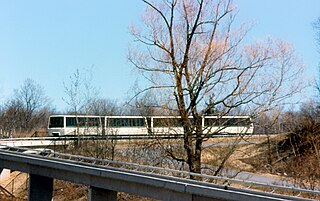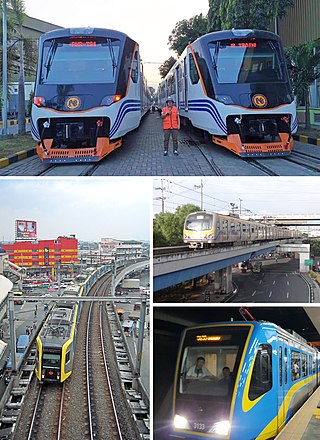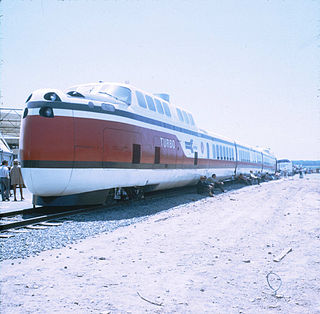Related Research Articles

Personal rapid transit (PRT), also referred to as podcars or guided/railed taxis, is a public transport mode featuring a network of specially built guideways on which ride small automated vehicles that carry few passengers per vehicle. PRT is a type of automated guideway transit (AGT), a class of system which also includes larger vehicles all the way to small subway systems. In terms of routing, it tends towards personal public transport systems.

A people mover or automated people mover (APM) is a type of small scale automated guideway transit system. The term is generally used only to describe systems serving relatively small areas such as airports, downtown districts or theme parks.

An automated guideway transit (AGT) or automated fixed-guideway transit or automatic guideway transit system is a type of fixed guideway transit infrastructure with a riding or suspension track that supports and physically guides one or more driverless vehicles along its length. The vehicles are often rubber tired or steel wheeled, but other traction systems including air cushion, suspended monorail and maglev have been implemented. The guideway provides both physical support, like a road, as well as the guidance. An automated line can be cheaper to run than a conventional line, due to the shorter trains and stations.

The Toronto Zoo Domain Ride was an automated guideway transit (AGT) service used to carry visitors between sections, or "domains", of the Toronto Zoo. Though technologically closer to a simple rubber-tired metro, it was almost universally referred to as a "monorail".

Rail transportation in the Philippines is currently used mostly to transport passengers within Metro Manila and provinces of Laguna and Quezon, as well as a commuter service in the Bicol Region. Freight transport services once operated in the country, but these services were halted. However, there are plans to restore old freight services and build new lines. From a peak of 1,100 kilometers (680 mi), the country currently has a railway footprint of 533.14 kilometers (331.28 mi), of which only 129.85 kilometers (80.69 mi) are operational as of 2024, including all the urban rail lines. World War II, natural calamities, underspending, and neglect have all contributed to the decline of the Philippine railway network. In the 2019 Global Competitiveness Report, the Philippines has the lowest efficiency score among other Asian countries in terms of efficiency of train services, receiving a score of 2.4, and ranking 86th out of 101 countries globally. The government is currently expanding the railway network up to 1,900 kilometers (1,200 mi) by 2022 through numerous projects.

The Department of Science and Technology, is the executive department of the Philippine government responsible for the coordination of science and technology-related projects in the Philippines and to formulate policies and projects in the fields of science and technology in support of national development.

Science and technology in the Philippines describes scientific and technological progress made by the Philippines and analyses related policy issues. The main agency responsible for managing science and technology (S&T) is the Department of Science and Technology (DOST). There are also sectoral councils for Forestry, Agriculture and Aquaculture, the Metal Industry, Nuclear Research, Food and Nutrition, Health, Meteorology, Volcanology and Seismology.

U.S. International Transportation Exposition, better known as Transpo '72, was a trade show held on 300 acres (1.2 km2) of land at Dulles International Airport outside Washington, D.C., for nine days from May 27 to June 4, 1972. The $10 million event, sponsored by the U.S. Department of Transportation, was a showcase for all sorts of transportation-related technologies. Over a million visitors flocked to the show from all over the world. According to the Wall Street Journal, it was "the biggest show the government has put on since World War II."

The Philippine Institute of Volcanology and Seismology is a Philippine national institution dedicated to provide information on the activities of volcanoes, earthquakes, and tsunamis, as well as other specialized information and services primarily for the protection of life and property and in support of economic, productivity, and sustainable development. It is one of the service agencies of the Department of Science and Technology.

The Dashaveyor was an automated guideway transit (AGT) system developed during the 1960s and '70s.

The University of the Philippines Diliman AGT was an automated guideway transit (AGT) system constructed for technology demonstration within the campus of the University of the Philippines (UP) in Diliman, Quezon City in the Philippines. It served as a test track for the first mass transit system to be built and developed in the country by local engineers.

The Bicutan AGT is an automated guideway transit (AGT) system under development as of 2024 within the City of Taguig in the Philippines. It will serve as test track for the second mass transit system to be built and developed in the country by local engineers.

Diwata-1 also known as PHL-Microsat-1 was a Philippine microsatellite launched to the International Space Station (ISS) on March 23, 2016, and was deployed into orbit from the ISS on April 27, 2016. It was the first Philippine microsatellite and the first satellite built and designed by Filipinos. It was followed by Diwata-2, launched in 2018.
The Metro Rail Transit Line 4 (MRT-4) is a proposed rapid transit line that would serve the Greater Manila Area of the Philippines. The 12.7 km (7.9 mi), 10-station elevated railway would connect Ortigas Center in Metro Manila and the suburban municipality of Taytay, Rizal. It would traverse along Ortigas Avenue and Manila East Road, starting at the former's junction with EDSA in Quezon City to the west until it terminates near the New Taytay Public Market to the east.

The following outline is provided as an overview of and topical guide to Metro Manila:

The following is an alphabetical list of articles related to the Philippine capital region of Metro Manila.

Project NOAH (Nationwide Operational Assessment of Hazard) is the Philippines' primary disaster risk reduction and management program. Managed by the University of the Philippines, it was initially administered by the Department of Science and Technology (DOST) from 2012 to 2017.

Fortunato "Boy" Tanseco de la Peña is a Filipino engineer and professor who served as the Secretary of Science and Technology in the Cabinet of President Rodrigo Duterte from 2016 to 2022. Before he assumed leadership of the Department of Science and Technology (DOST), he was the Undersecretary for Scientific and Technological Services from 2001 to 2014. Except for his brief retirement from 2014 to 2016, he has been with the department since 1982.

The Hybrid Electric Train (HET) is a hybrid electric train built by the Department of Science and Technology's Metals Industry Research and Development Center.
The Cebu Monorail Transit System, simply known as the Cebu Monorail, is a proposed monorail rapid transit system to be built in Metro Cebu, Philippines. Originally proposed by the Japanese in 2015 as the Cebu MRT System, it was revised to a light rail line in the late 2010s, dubbed the Cebu Light Rail Transit System or Cebu LRT. It was then again revised to its present form in late 2019.
References
- 1 2 3 4 5 6 Alcasid, Edgilyn (December 15, 2014). "Filipino-made Automated Guide-Way Transit System (AGT) eyes to curb air pollution and traffic". Philippine Council for Industry, Energy and Emerging Technology Research and Development. Retrieved October 21, 2018.
- 1 2 3 4 5 6 "DOST Chief, UP Prez test run the first ever Filipino-developed train". Department of Science and Technology. December 18, 2012. Retrieved October 21, 2018.
- ↑ Tupaz, Voltaire (December 16, 2012). "UP, DOST to design cheaper train after test run". Rappler. Retrieved October 21, 2018.
![]() This article incorporates text from this source, which is in the public domain :Alcasid, Edgilyn (December 15, 2014). "Filipino-made Automated Guide-Way Transit System (AGT) eyes to curb air pollution and traffic". Philippine Council for Industry, Energy and Emerging Technology Research and Development. Retrieved October 21, 2018.
This article incorporates text from this source, which is in the public domain :Alcasid, Edgilyn (December 15, 2014). "Filipino-made Automated Guide-Way Transit System (AGT) eyes to curb air pollution and traffic". Philippine Council for Industry, Energy and Emerging Technology Research and Development. Retrieved October 21, 2018.